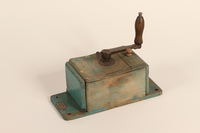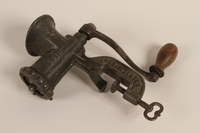Overview
- Brief Narrative
- Cast metal charcoal iron of the type used in the Łódź Ghetto in German-occupied Poland from May 1940 to August 1944. Łódź was occupied by Germany a week after the September 1, 1939, invasion of Poland. The city was renamed Litzmannstadt, and in February 1940, approximately 160,000 people from the Jewish population were confined to a small, closed ghetto. All residents had to work, and many became forced laborers in ghetto factories. Eventually, nearly 100 factories were in operation. The major ones produced textiles, including uniforms for the Germany Army. In the ghetto, people attempted to maintain their normal lives, despite the increasing hardships. Women, when they were not laboring in the factories, worked to prepare food and do laundry for their families. These activities were made difficult by the meager food rations they received, and the lack of running water throughout most of the ghetto. Due to the severe overcrowding and scarce food, disease and starvation were common. The Judenrat (Jewish Council) were forced to administer the ghetto for the Germans. Judenrat chairman, Mordechai Rumkowski, thought hard work and increased manufacturing output would preserve the ghetto, but in January 1942, mass deportations to Chelmno killing center began. By the end of the year, half of the residents were murdered. In summer 1944, Łódź, the last ghetto in Poland, was destroyed, and the remaining Jews were sent to Chelmno and Auschwitz-Birkenau killing centers.
- Date
-
use:
approximately 1900-approximately 1945
- Geography
-
use:
Poland.
- Credit Line
- United States Holocaust Memorial Museum Collection
Physical Details
- Classification
-
Personal Equipment and Supplies
- Object Type
-
Irons (Pressing) (lcsh)
- Genre/Form
- Appliances.
- Physical Description
- Cast metal, triangular, charcoal iron with a wooden handle. The body is hollow, with a flat base and top, and sides that taper into a point at the front. There are seven small holes cut along the lower edge of each side and a horizontal line cut above. The back is open with a rectangular-shaped hole where a cover used to be. The two screws used to hold the cover are still in place above the opening. The handle is an open loop of curved, smooth wood that is formed into a point at the front, and has an oval-shaped wooden base. The base rests on a curved metal support that is bolted into the top of the iron. The iron is very worn and stained overall.
- Dimensions
- overall: Height: 7.500 inches (19.05 cm) | Width: 7.125 inches (18.098 cm) | Depth: 3.125 inches (7.938 cm)
- Materials
- overall : cast iron, metal, wood
Rights & Restrictions
- Conditions on Access
- No restrictions on access
- Conditions on Use
- No restrictions on use
Keywords & Subjects
- Topical Term
- Forced labor--Poland--Łódź. Holocaust, Jewish (1939-1945)--Poland. Jewish ghettos--Poland--Łódź. Jewish women in the Holocaust--Poland. Jews--Persecutions--Poland. Slave labor--Poland--Łódź. Textile workers--Poland. World War, 1939-1945--Conscript labor--Poland--Łódź.
- Geographic Name
- Łódź (Poland)
- Corporate Name
- Litzmannstadt-Getto (Łódź, Poland)
Administrative Notes
- Legal Status
- Permanent Collection
- Provenance
- The iron was acquired by the United States Holocaust Memorial Museum in 1990.
- Record last modified:
- 2023-06-14 07:09:17
- This page:
- https://collections.ushmm.org/search/catalog/irn4112
Also in Krakow, Poland collection
The collection consists of clothing irons, a coffee mill, a meat grinder, and a scale relating to Krakow, Poland before and during the Holocaust.
Date: approximately 1900-approximately 1945

Manual hanging hand crank coffee mill
Object
Wooden, wall hanging, coffee mill of the type used in the Łódź Ghetto in German-occupied Poland from May 1940 to August 1944. Łódź was occupied by Germany a week after the September 1, 1939, invasion of Poland. The city was renamed Litzmannstadt, and in February 1940, approximately 160,000 people from the Jewish population were confined to a small, closed ghetto. All residents had to work, and many became forced laborers in ghetto factories. Eventually, nearly 100 factories were in operation. The major ones produced textiles, including uniforms for the Germany Army. In the ghetto, people attempted to maintain their normal lives, despite the increasing hardships. Women, when they were not laboring in the factories, worked to prepare food and do laundry for their families. These activities were made difficult by the meager food rations they received, and the lack of running water throughout most of the ghetto. Due to the severe overcrowding and scarce food, disease and starvation were common. The Judenrat (Jewish Council) were forced to administer the ghetto for the Germans. Judenrat chairman, Mordechai Rumkowski, thought hard work and increased manufacturing output would preserve the ghetto, but in January 1942, mass deportations to Chelmno killing center began. By the end of the year, half of the residents were murdered. In summer 1944, Łódź, the last ghetto in Poland, was destroyed, and the remaining Jews were sent to Chelmno and Auschwitz-Birkenau killing centers.

Manual hand crank meat grinder
Object
Manual hand-crank meat grinder of the type used in the Łódź Ghetto in German-occupied Poland from May 1940 to August 1944. Łódź was occupied by Germany a week after the September 1, 1939, invasion of Poland. The city was renamed Litzmannstadt, and in February 1940, approximately 160,000 people from the Jewish population were confined to a small, closed ghetto. All residents had to work, and many became forced laborers in ghetto factories. Eventually, nearly 100 factories were in operation. The major ones produced textiles, including uniforms for the Germany Army. In the ghetto, people attempted to maintain their normal lives, despite the increasing hardships. Women, when they were not laboring in the factories, worked to prepare food and do laundry for their families. These activities were made difficult by the meager food rations they received, and the lack of running water throughout most of the ghetto. Due to the severe overcrowding and scarce food, disease and starvation were common. The Judenrat (Jewish Council) were forced to administer the ghetto for the Germans. Judenrat chairman, Mordechai Rumkowski, thought hard work and increased manufacturing output would preserve the ghetto, but in January 1942, mass deportations to Chelmno killing center began. By the end of the year, half of the residents were murdered. In summer 1944, Łódź, the last ghetto in Poland, was destroyed, and the remaining Jews were sent to Chelmno and Auschwitz-Birkenau killing centers.
Metal balance scale with two measuring trays used in a store
Object
Metal measuring scale with two trays, of the type used in the Łódź Ghetto in German-occupied Poland from May 1940 to August 1944. Łódź was occupied by Germany a week after the September 1, 1939, invasion of Poland. The city was renamed Litzmannstadt, and in February 1940, approximately 160,000 people from the Jewish population were confined to a small, closed ghetto. All residents had to work, and many became forced laborers in ghetto factories. Eventually, nearly 100 factories were in operation. The major ones produced textiles, including uniforms for the Germany Army. Due to the severe overcrowding and scarcity of food, disease and starvation were common. The Judenrat (Jewish Council) were forced to administer the ghetto for the Germans. Judenrat chairman, Mordechai Rumkowski, thought hard work and increased manufacturing output would preserve the ghetto, but in January 1942, mass deportations to Chelmno killing center began. By the end of the year, half of the residents were murdered. In summer 1944, Łódź, the last ghetto in Poland, was destroyed, and the remaining Jews were sent to Chelmno and Auschwitz-Birkenau killing centers.
Cast metal chimney iron with a wooden handle
Object
Cast metal chimney iron of the type used in the Łódź Ghetto in German-occupied Poland from May 1940 to August 1944. Łódź was occupied by Germany a week after the September 1, 1939, invasion of Poland. The city was renamed Litzmannstadt, and in February 1940, approximately 160,000 people from the Jewish population were confined to a small, closed ghetto. All residents had to work, and many became forced laborers in ghetto factories. Eventually, nearly 100 factories were in operation. The major ones produced textiles, including uniforms for the Germany Army. In the ghetto, people attempted to maintain their normal lives, despite the increasing hardships. Women, when they were not laboring in the factories, worked to prepare food and do laundry for their families. These activities were made difficult by the meager food rations they received, and the lack of running water throughout most of the ghetto. Due to the severe overcrowding and scarce food, disease and starvation were common. The Judenrat (Jewish Council) were forced to administer the ghetto for the Germans. Judenrat chairman, Mordechai Rumkowski, thought hard work and increased manufacturing output would preserve the ghetto, but in January 1942, mass deportations to Chelmno killing center began. By the end of the year, half of the residents were murdered. In summer 1944, Łódź, the last ghetto in Poland, was destroyed, and the remaining Jews were sent to Chelmno and Auschwitz-Birkenau killing centers.
Cast metal charcoal iron with hinged top and wooden handle
Object
Cast metal charcoal iron of the type used in the Łódź Ghetto in German-occupied Poland from May 1940 to August 1944. Łódź was occupied by Germany a week after the September 1, 1939, invasion of Poland. The city was renamed Litzmannstadt, and in February 1940, approximately 160,000 people from the Jewish population were confined to a small, closed ghetto. All residents had to work, and many became forced laborers in ghetto factories. Eventually, nearly 100 factories were in operation. The major ones produced textiles, including uniforms for the Germany Army. In the ghetto, people attempted to maintain their normal lives, despite the increasing hardships. Women, when they were not laboring in the factories, worked to prepare food and do laundry for their families. These activities were made difficult by the meager food rations they received, and the lack of running water throughout most of the ghetto. Due to the severe overcrowding and scarce food, disease and starvation were common. The Judenrat (Jewish Council) were forced to administer the ghetto for the Germans. Judenrat chairman, Mordechai Rumkowski, thought hard work and increased manufacturing output would preserve the ghetto, but in January 1942, mass deportations to Chelmno killing center began. By the end of the year, half of the residents were murdered. In summer 1944, Łódź, the last ghetto in Poland, was destroyed, and the remaining Jews were sent to Chelmno and Auschwitz-Birkenau killing centers.



